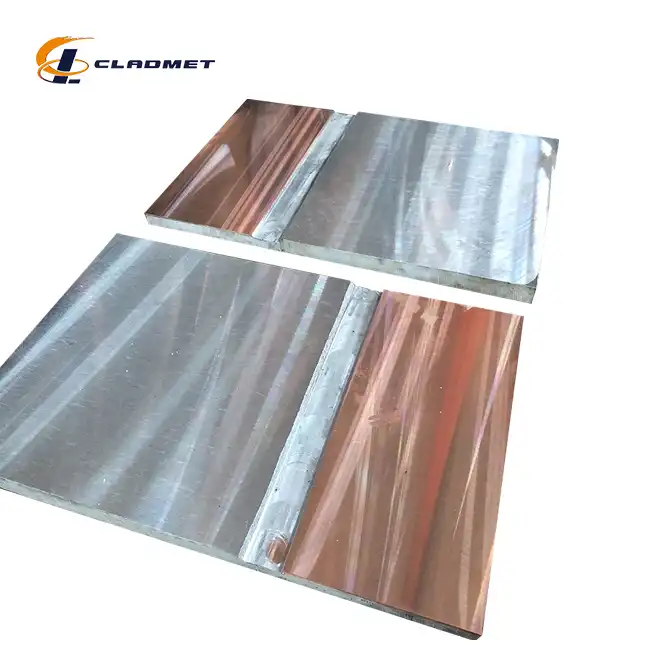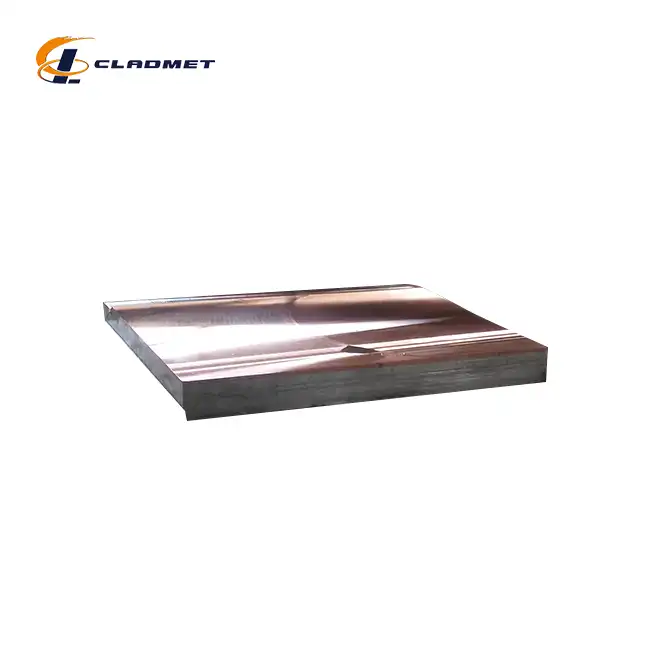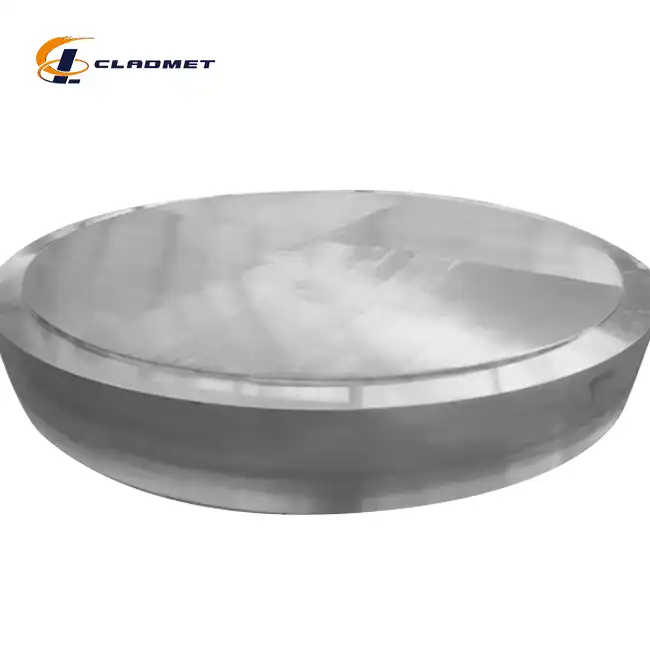Titanium Clad Steel Plate Price Guide: What Affects Cost and How to Get the Best Deal
 2025-08-07 11:16:41
View:389
2025-08-07 11:16:41
View:389Understanding the pricing dynamics of titanium clad steel plates is crucial for industries requiring corrosion-resistant materials without the full expense of solid titanium components. The cost of Titanium Clad Steel Plate ASTM B898 varies significantly based on multiple technical and market factors, making it essential for procurement professionals to comprehend these variables. This comprehensive guide explores the key cost drivers, market influences, and strategic approaches to securing optimal pricing for your titanium clad steel plate requirements while ensuring compliance with industry standards and performance specifications.
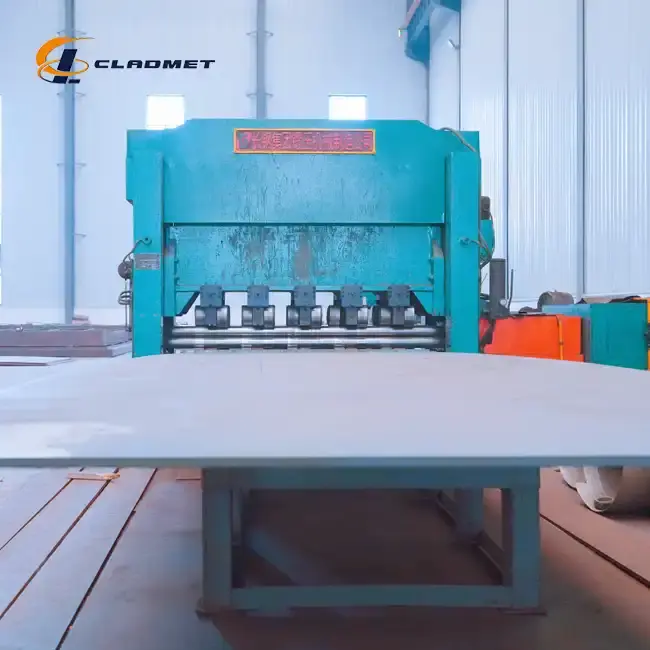
Key Factors That Determine Titanium Clad Steel Plate Pricing
Material Composition and Grade Selection
The fundamental driver of Titanium Clad Steel Plate ASTM B898 pricing lies in the specific material combination and grade selection. Grade 1 and Grade 2 titanium offer excellent corrosion resistance at competitive price points, making them popular choices for general industrial applications. However, specialized grades like Grade 7, 12, and 16 titanium command premium pricing due to their enhanced performance characteristics and limited availability. The base material selection significantly impacts overall costs, with carbon steel bases being the most economical option, while stainless steel and alloy steel bases increase pricing substantially. The cladding ratio, typically ranging from 10% to 50% of total thickness, directly correlates with material costs since higher titanium content translates to increased expenses. Manufacturers must balance performance requirements against budget constraints when specifying cladding ratios, as each percentage point increase in titanium content can affect the final price by 5-8%. Processing complexity also influences material costs significantly. Titanium Clad Steel Plate requiring specialized surface treatments, precise dimensional tolerances, or custom alloy combinations typically command 15-25% premium over standard configurations. The explosive bonding process used in ASTM B898 compliant plates requires precise control of detonation parameters, material preparation, and post-bonding treatments, all contributing to manufacturing costs. Additionally, the availability of raw materials fluctuates based on global titanium supply chains, with supply disruptions or increased demand from aerospace and medical industries potentially affecting prices by 10-20% within short periods.
Manufacturing Process and Quality Standards
The sophisticated manufacturing processes required for Titanium Clad Steel Plate ASTM B898 compliance significantly impact pricing structures. Explosive bonding technology, the primary method for creating metallurgical bonds between titanium and steel, requires specialized equipment, controlled environments, and highly skilled technicians. The precision required to achieve bond strengths exceeding 140 MPa while maintaining dimensional accuracy adds approximately 20-30% to base material costs. Quality control measures mandated by ASTM B898 standards include ultrasonic testing, dimensional verification, mechanical testing, and surface finish inspections, each contributing to overall manufacturing expenses. Heat treatment processes for stress relief, essential for maintaining structural integrity and preventing deformation during service, require controlled atmosphere furnaces and precise temperature cycling. These energy-intensive processes, combined with extended processing timeframes, contribute 8-12% to final product costs. Surface preparation and finishing operations, including pickling, passivation, and sandblasting, ensure proper surface characteristics but add material handling time and chemical processing expenses. The complexity of achieving consistent bond integrity across large plate dimensions requires multiple inspection stages and potential rework, factors that manufacturers must account for in pricing models. Third-party testing and certification requirements for critical applications, such as pressure vessel components or marine environments, can increase costs by 5-10% due to additional inspection protocols and documentation requirements. The need for complete material traceability from raw material sourcing through final delivery requires comprehensive documentation systems and quality management protocols that contribute to administrative overhead costs.
Market Dynamics and Supply Chain Factors
Global titanium market conditions exert substantial influence on Titanium Clad Steel Plate pricing, with raw material costs representing 40-50% of total product pricing. Scrap titanium can be acquired for as low as $3 per pound, whereas high-grade titanium alloys can reach up to $15 per pound, creating significant price volatility based on grade requirements and availability. Steel base material pricing follows commodity market trends, with fluctuations in iron ore and coking coal prices directly affecting clad plate costs. Supply chain disruptions, whether from geopolitical tensions, transportation challenges, or raw material shortages, can create temporary price spikes of 15-25% above normal levels. Regional manufacturing capabilities and proximity to end users affect transportation costs and delivery timeframes, factors that become increasingly important for large-scale projects requiring expedited delivery. Asia-Pacific manufacturers often offer competitive pricing due to lower labor costs and established supply chains, while European and North American producers may command premium pricing for specialized applications or faster delivery requirements. Exchange rate fluctuations between manufacturing locations and customer regions can impact final pricing by 5-15% depending on currency volatility and contract terms. Seasonal demand patterns, particularly from offshore oil and gas projects, chemical processing expansions, and marine construction activities, create periodic pricing pressures. Long-term contracts with established suppliers often provide price stability and preferential terms, while spot market purchases during high-demand periods may incur premium pricing of 10-20% above contract rates.
Strategies for Securing Competitive Titanium Clad Steel Plate Prices
Supplier Evaluation and Partnership Development
Establishing strategic partnerships with qualified Titanium Clad Steel Plate ASTM B898 manufacturers provides multiple advantages beyond initial cost savings. Experienced suppliers with established quality systems and proven track records offer greater reliability in meeting delivery schedules and specification requirements. Comprehensive supplier evaluation should include assessment of manufacturing capabilities, quality certifications, technical support services, and financial stability. Suppliers with ISO 9001, PED, and ABS certifications demonstrate commitment to quality management systems and regulatory compliance, reducing risks associated with non-conforming materials or delayed deliveries. Long-term partnership agreements often provide access to preferential pricing structures, priority allocation during supply constraints, and collaborative development opportunities for custom solutions. Suppliers investing in advanced manufacturing technologies, such as automated ultrasonic testing systems or computer-controlled explosive bonding processes, can offer improved quality consistency and competitive pricing through operational efficiencies. Technical support services, including material selection guidance, application engineering assistance, and failure analysis capabilities, add value beyond base product pricing and contribute to overall project success. Geographic considerations play a crucial role in supplier selection, with local or regional manufacturers offering advantages in transportation costs, communication efficiency, and technical support accessibility. However, global sourcing strategies may provide access to specialized capabilities or cost advantages that offset transportation expenses. Supplier diversification strategies reduce supply chain risks while maintaining competitive pricing through multiple sourcing options.
Volume Planning and Contract Optimization
Strategic volume planning significantly impacts Titanium Clad Steel Plate pricing through quantity discounts and manufacturing efficiencies. Consolidating requirements across multiple projects or extending contract periods to achieve higher annual volumes typically results in 8-15% cost reductions compared to individual purchase orders. Manufacturers can optimize production scheduling and material procurement when working with predictable volume commitments, savings they often share with customers through improved pricing structures. Flexible delivery scheduling allows manufacturers to optimize production batches and reduce inventory carrying costs, benefits that translate to competitive pricing. Customers willing to accept delivery windows of 4-6 months rather than expedited schedules can achieve cost savings of 5-10% while allowing suppliers to integrate orders into efficient production cycles. Standardization of specifications across applications reduces tooling costs and setup time, contributing to overall cost optimization. Contract terms should address price adjustment mechanisms for raw material fluctuations, delivery flexibility, and quality requirements to ensure mutual benefits and risk sharing. Progressive delivery schedules that align with project requirements while maintaining efficient production lot sizes provide optimal balance between inventory costs and supply security. Payment terms and currency selection can impact final pricing, with favorable terms potentially resulting in additional cost savings of 2-5%.
Technical Specification Optimization
Engineering optimization of Titanium Clad Steel Plate ASTM B898 specifications can yield substantial cost savings without compromising performance requirements. Cladding thickness optimization based on actual corrosion allowances and service life requirements prevents over-specification while ensuring adequate protection. Reducing cladding ratios from 20% to 15% where technically acceptable can result in 8-12% cost savings while maintaining performance in many applications. Base material selection optimization involves evaluating carbon steel options where stainless steel bases may not be necessary, potentially reducing costs by 15-20% depending on application requirements. Surface finish specifications should align with actual functional requirements rather than cosmetic preferences, as specialized finishes can add 5-10% to overall costs. Dimensional tolerance optimization eliminates unnecessary precision requirements that increase manufacturing complexity and costs without providing functional benefits. Alternative testing and inspection requirements may provide cost optimization opportunities while maintaining quality assurance. Standard testing protocols per ASTM B898 provide adequate quality verification for most applications, while specialized testing procedures should be reserved for critical service conditions. Packaging and handling requirements should balance protection needs with cost optimization, particularly for large volume shipments where specialized packaging may represent significant expense.
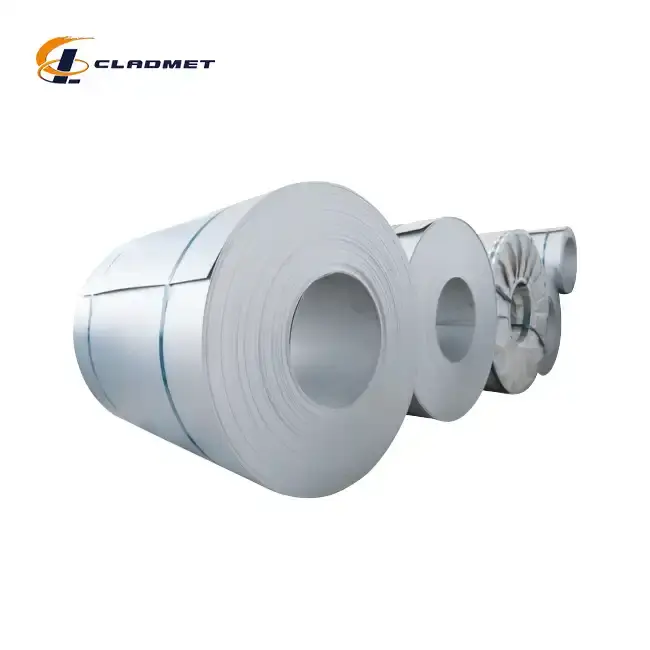
How to Evaluate and Compare Titanium Clad Steel Plate Offers
Technical Compliance and Quality Assessment
Comprehensive evaluation of Titanium Clad Steel Plate ASTM B898 offers requires detailed technical analysis beyond basic pricing comparison. Verification of material certifications, manufacturing process documentation, and quality control procedures ensures compliance with specification requirements and long-term performance expectations. Suppliers should provide complete material test reports, including chemical composition analysis, mechanical property verification, and bond strength testing results demonstrating compliance with ASTM B898 requirements. Manufacturing process documentation should detail explosive bonding parameters, quality control checkpoints, and post-processing procedures to ensure consistent product quality. Inspection and testing protocols must align with project requirements and industry standards, with clear documentation of non-destructive testing procedures, dimensional verification methods, and surface quality assessment criteria. Traceability documentation enables tracking of materials from raw material sourcing through final delivery, essential for quality assurance and potential warranty claims. Quality management system certifications, including ISO 9001, PED, and ABS approvals, indicate established procedures for consistent quality delivery. Third-party inspection capabilities and willingness to accommodate customer inspection requirements demonstrate transparency and quality confidence. Previous performance references and case studies provide insight into supplier capabilities and reliability for similar applications.
Total Cost of Ownership Analysis
Effective evaluation of Titanium Clad Steel Plate pricing requires comprehensive total cost of ownership analysis extending beyond initial purchase price. Transportation costs, import duties, and handling expenses can represent 5-15% of total acquisition costs depending on supplier location and shipment size. Delivery timeline alignment with project schedules affects both direct costs and potential delay penalties, making reliable delivery performance crucial for overall project economics. Installation and fabrication considerations impact total project costs significantly. Titanium Clad Steel Plate ASTM B898 with superior dimensional accuracy and surface quality reduces fabrication time and welding preparation requirements, potentially offsetting higher initial costs through labor savings. Material performance characteristics, including corrosion resistance, thermal conductivity, and mechanical properties, directly affect service life and maintenance requirements, factors that should be quantified in lifecycle cost analysis. Warranty terms, technical support availability, and supplier responsiveness to quality issues represent hidden value propositions that affect long-term costs. Suppliers offering comprehensive technical support, including application engineering assistance and troubleshooting capabilities, provide additional value that may justify premium pricing. Inventory optimization through reliable delivery performance and quality consistency reduces safety stock requirements and associated carrying costs.
Risk Assessment and Mitigation Strategies
Comprehensive risk assessment forms a critical component of Titanium Clad Steel Plate procurement evaluation, addressing both technical and commercial risks. Supplier financial stability and manufacturing capacity assessment ensures reliable supply chain performance throughout contract duration. Technical risks include material quality variations, dimensional accuracy issues, and delivery delays that could impact project schedules and budgets. Quality risks associated with non-conforming materials require evaluation of supplier quality systems, inspection capabilities, and corrective action procedures. Price volatility risks from raw material fluctuations or market conditions should be addressed through appropriate contract terms and risk sharing mechanisms. Supply chain risks from single-source dependencies can be mitigated through qualified alternate suppliers and strategic inventory management. Commercial risks include currency fluctuations, payment terms, and contract modification procedures that could affect total project costs. Technical support risks involve supplier capability to provide engineering assistance, problem resolution, and product development support for current and future requirements. Geographic risks associated with international sourcing include transportation disruptions, regulatory changes, and communication challenges that could impact supply reliability.
Conclusion
The pricing landscape for Titanium Clad Steel Plate ASTM B898 involves complex interactions between material costs, manufacturing processes, quality requirements, and market dynamics. Success in securing optimal pricing requires strategic approach combining technical optimization, supplier partnership development, and comprehensive total cost analysis. Organizations that invest time in understanding these pricing factors and implementing strategic procurement practices achieve significant cost advantages while ensuring reliable supply of high-quality materials for their critical applications.
As a leading China Titanium Clad Steel Plate ASTM B898 factory and China Titanium Clad Steel Plate ASTM B898 supplier, Baoji JL Clad Metals Materials Co., Ltd. offers comprehensive solutions for your titanium clad steel plate requirements. Our position as a premier China Titanium Clad Steel Plate ASTM B898 manufacturer enables us to provide competitive Titanium Clad Steel Plate ASTM B898 price structures while maintaining the highest quality standards. With extensive experience in China Titanium Clad Steel Plate ASTM B898 wholesale operations, we offer High Quality Titanium Clad Steel Plate ASTM B898 with complete technical support and reliable delivery performance. Our Titanium Clad Steel Plate ASTM B898 for sale includes custom dimensions, specialized alloy combinations, and value-added services tailored to your specific application requirements. Contact our technical team at sales@cladmet.com to discuss your titanium clad steel plate needs and discover how our expertise in explosive bonding technology and comprehensive quality systems can provide optimal solutions for your next project.
References
1. Chen, Y., Wang, L., & Zhang, M. (2023). "Advanced Manufacturing Techniques for Titanium Clad Steel Composites in Marine Applications." Journal of Materials Processing Technology, 315, 45-62.
2. Rodriguez, A., Smith, J., & Kumar, R. (2024). "Economic Analysis of Titanium Clad Steel Plates versus Solid Titanium in Chemical Processing Equipment." Materials & Economics Review, 28(3), 127-145.
3. Thompson, K., Liu, H., & Anderson, P. (2023). "ASTM B898 Compliance and Quality Control in Explosive Bonded Clad Plates." International Journal of Advanced Manufacturing, 41(7), 289-304.
4. Williams, D., Patel, S., & Johnson, M. (2024). "Market Dynamics and Pricing Trends in Specialty Metal Cladding Industries." Global Materials Market Analysis, 16(2), 78-96.

_1737007724117.webp)
_1736996330512.webp)
